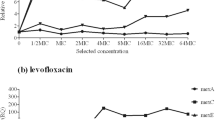Abstract
Ciprofloxacin resistance mechanisms were studied by investigating the inhibitory effect of ciprofloxacin on the gyrase-mediated DNA supercoiling and the intracellular accumulation of ciprofloxacin in clinical isolates ofPseudomonas aeruginosa. A higher amount of ciprofloxacin was required to inhibit the gyrases purified from the ciprofloxacin-resistant strains than that from the sensitive strain. Reconstitution of heterologous gyrase subunits from different strains revealed alterations in the A and/or the B subunits of gyrase in these strains. In addition, the resistant strains accumulated approximately a half amount of ciprofloxacin inside the cells, compared to the sensitive strain. However, when the active efflux was blocked by carbonyl cyanide m-chlorophenyl hydrazone treatment, intracellular concentration of ciprofloxacin was elevated about 4–7 fold in these strains, while the sensitive strain was not significantly affected by this treatment, indicating that the ciprofloxacin-resistant strains developed a drug efflux system. Interestingly, these resistant strains expressed an envelope protein of approximately 51 kD. These studies suggest that alterations in the gyrase as well as the active drug-efflux system conferred dual ciprofloxacin resistance mechanisms to these clinical isolates ofP. aeruginosa.
Similar content being viewed by others
References Cited
Aoyama, H., Sato, K., Fujii, T., Fujimaki, K., Inoue, M., and Mitsuhashi, S., Purification ofCitrobacter freundii.Antimicrob. Agents Chemother., 32, 104–109 (1988).
Cullen, M. E., Wyke, A. W., Kuroda, R., and Fisher, L. M., Cloning and characterization of a DNA gyrase A gene fromEscherichia coli that confers clinical resistance to 4-quinolones.Antimicrob. Agents Chemother., 3, 886–894 (1989).
Fukuda, H., Hosoka, M., Hirai, K., and Iyobe, S. New norfloxacin resistance inPseudomonas aeruginosa PAO.Antimicrob. Agents Chemother., 34, 1757–1761 (1990).
Heisig, P., Schedletzky, H., and Falkenstein-Paul, H., Mutations in the gyrA gene of a highly fluoro-quinolone-resistant clinical isolate ofEscherichia coli.Antimicrob. Agents Chemother. 37, 696–701.
Hirai, K., Suzue, S., Irikura, T., Ioyobe, S., and Mitsuhashi, S., Mutations producing resistances to norfloxacin inPseudomonas aeruginosa.Antimicrob. Agents Chemother. 31, 582–586 (1987).
Hooper, D. C., Wolfson, J. S., Souza, K. S., Tung, C., McHugh, G. L., and Swartz, M. N., Genetic and biochemical characterization of norfloxacin resistance inEscherichia coli.Antimicrob. Agents Chemother., 29, 639–644 (1986).
Ito, H., Yoshida, H., Bogaki-Shonai, M., Niga, T., Hattori, H. and Nakamura, S., Quinolone resistance mutations in the DNA gyrase gyrA and gyrB genes ofStaphylococcus aureus.Antimicrob. Agents Chemother., 38, 2014–2023 (1994).
Kaatz, G. W., Seo, S. M., and Ruble, C. A., Efflux-mediated fluoroquinolone resistance inStaphylococcus aureus.Antimicrob. Agents Chemother., 37, 1086–1094 (1993).
Lei, Y., Sato, K., and Nakae, T., Ofloxacin-resistantPseudomonas aeruginosa mutants with elevated drug extrusion across the inner membrane.Biochem. Biophys. Res. Comm., 178, 1043–1048 (1991).
Masecar, B. L., Celesk, R. A., and Robillard, N. J., Analysis of acquired ciprofloxacin resistance in a clinical strain ofPseudomonas aeruginosa.Antimicrob. Agents Chemother., 34, 281–286 (1990).
Okuda, J., Okamoto, S., Takahata, M., and Nishino, T. Inhibitory effects of ciprofloxacin and sparfloxacin on DNA gyrase purified from fluoroquinolone resistant strains of methicillin resistantStaphylococcus aureus.Antimicrob. Agents Chemother., 35, 2288–2293 (1991).
Poxton, I. R., Bell, G. T., and Barclay, G. R., The association on SDS-polyacrylamide gels of lipo-polysaccharide and outer membrane proteins ofPseudomonas aeruginosa as revealed by monoclonal antibodies and Western blotting.FEMS Microbiol. Lett. 27, 247–251 (1985).
Staudenbauer, W. L., and Orr, E., DNA gyrase: affinity chromatography on novobiocin-sepharose and catalytic properties.Nucleic Acids Res., 9, 3589–3603 (1981).
Yamagishi, J., Yoshida, H., Yamayosh, M., and Nakamura, S., Naladixic acid resistant mutations of the gyrB gene ofEscherichia coli.Mol. Gen. Genet. 204, 367–373 (1986).
Yoshida, H., Bogaki, M., Nakamura, M., Yamanaka, L., and Nakamura, S., Quinolone resistance-determining region in the DNA gyrase gyrB gene ofEscherichia coli.Antimicrob. Agents Chemother., 35, 1647–1650 (1991).
Yoshida, H., Nakamura, M., Bogaki, M., Ito, H., Kojima, T., Hattori, H., and Nakamura, S., Mechanism of action of quinolones againstEscherichia coli DNA gyrase.Antimicrob. Agents Chemother., 37, 839–845 (1993).
Author information
Authors and Affiliations
Rights and permissions
About this article
Cite this article
Cho, M., Kim, D., Kong, J.Y. et al. Ciprofloxacin resistance by altered gyrase and drug efflux system inPseudomonas aeruginosa . Arch. Pharm. Res. 18, 173–178 (1995). https://doi.org/10.1007/BF02979191
Received:
Issue Date:
DOI: https://doi.org/10.1007/BF02979191




